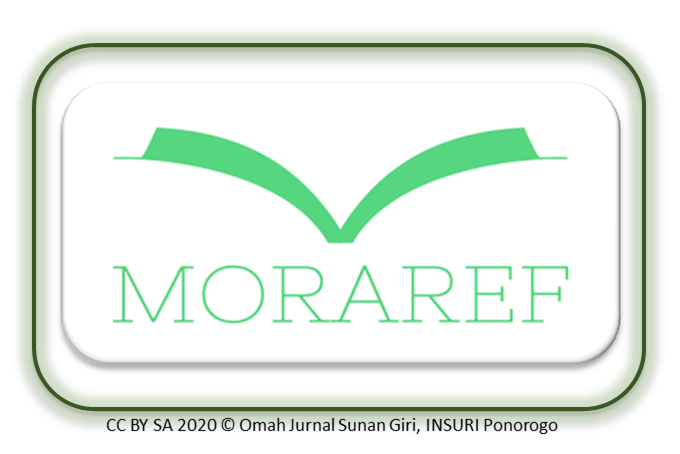Representation of the Pancajiwa of Islamic Boarding Schools in the Film "Cahaya Cinta Pesantren"
Keywords:
Representation, Islamic Boardiang Schools, SemioticsAbstract
This article represents the pancajiwa (five souls) of Islamic boarding schools in the film "Cahaya Cinta Pesantren" using Charles Sanders Peirce's semiotic techniques, Peirce's triadic model, often also called Peirce's triangular theory of meaning, which consists of signs, objects, and interpretants. This article uses qualitative and semiotic methods, as well as document study. The purpose of this article is to represent the pancajiwa (five souls) of Islamic boarding schools in the film "Cahaya Cinta Pesantren". The results of this research show that the film "Cahaya Cinta Pesantren" contains the five souls of Islamic boarding schools in the form of the spirit of sincerity, namely sincerity in terms of giving because of God Allah, seeking knowledge and being warned, the spirit of simplicity in clothing, places to study, worship and to eat, the spirit of independence, namely independence in self-actualization and daily activities, the spirit of Ukhuwah Islamiyah namely brotherhood in overcoming problems without prioritizing individual egos and prioritizing togetherness and happiness of other people, the spirit of freedom, namely freedom of expression and work.
References
Anggraini, Rizka Gusti, Rubino,Irma Yusriani Simamora, (2022). Dakwah Bil Hal dan Ideologi Humanis Religius Wanita Muslim dalam Film Indonesia. Muharrik: Jurnal Dakwah dan Sosial. Vol. 5. No.2.
Ali Muhammad, (2017). Ekranisasi Unsur Naratif dalam Film Cahaya Cinta Pesantren Sutradara Raymond Handaya, vol. 2.
Batubara Jihan Afri, (2023). Virtual Da’wa Communication between Ustad Yazid Jawas and Ustad Abdul Somad on YouTube. Muharrik: Jurnal Dakwah dan Sosial. Vol. 6. No.1.
Cangara, Hafied. (2011). Pengantar Ilmu Komunikasi. Jakarta: Rajawali Pers.
Danesi, Marcel. 2010. Pesan, Tanda, dan Makna: Buku Teks Dasar Mengenai Semiotika dan Teori Komunikasi. Yogyakarta: Jalasutra.
Dwijayanto, A., & Multazam, D. (2021). Pancasila and Rukun Negara: A Relation of Identity, State, and Nationalism in Indonesia and Malaysia. Tebuireng: Journal of Islamic Studies and Society, 2(1).
Kasiram, Moh. (2008). Metode Penelitian. Malang: UIN Malang Press.
Kriyantono, Rachmat.(2010). Teknik Praktis Riset Komunikasi. Jakarta: Kencana.
Kuswandi, Iwan, dan Ihwan Amalih. (2015). Sang Konseptor pesantren KH. Muhammad Idris Jauhari. Yogyakarta: Lembaga Ladang Karya.
Marwantika, Asna Istya. (2021). The Sacralization of the Myth of Prohibition of Leaving the House at Dusk in Sandekala Film: Charles Sanders Pierce’s Semiotic Analysis. Muharrik: Jurnal Dakwah dan Sosial. Vol 4. No 1.
Miftahuddin, Laili Human. (2018) Ulama dan Media Sosial: Analisis Pesan Dakwah KH Mustofa Bisri di Twitter. Muharrik: Jurnal Dakwah dan Sosial. Vol 1. No 2.
Mubasyaroh. (2014). At-Tabsyir, Jurnal Komunikasi Penyiaran Islam. vol.2. Film Sebagai Media Dakwah (Sebuah Tawaran Alternative Media Dakwah Kontemporer).
Mujib dkk, (2016). Intelektual Pesantren, Jakarta: DIVA PUSTAKA.
Muchlis, I. (2017). MEMPERTIMBANGKAN NILAI ADIL DALAM WARISAN: Perspektif Naṣr Ḥāmid Abū Zayd. QOF, 1(2).
Noth, Winfried. (2006). Semiotik. Surabaya: Airlangga University Press.
Tim Penulis. (2006).Profil Pondok Modern Darussalam Gontor, Gontor: Pondok Modern Darussalam Gontor.
RI, Departemen Agama. (2011). Al-Qur’an dan Terjemahannya. Bandung: CV Penerbit Diponegoro.
Rusli, Moh. (2013). Metode Penelitian Kuantitatif dan Kualitatif Berorientasi Praktis. Sumenep: LP3 PARAMADANI.
Salas, H. J., & Kartika, T. (2020). Representasi Identitas Santri (Analisis Semiotika Model John Fiske dalam Film Cahaya Cinta Pesantren). Al-Mishbah: Jurnal Ilmu Dakwah dan Komunikasi, 16(1).
Staf Sekretariat PMDG, (1997). Serba Serbi Serba Singkat tentang Pondok Modern Darussalam Gontor, Gontor: Percetakan Darussalam.
Sobur, Alex. (2013). Semiotika Komunikasi. Bandung: Remaja Rosdakarya.
Syarifuddin, Muhammad. (2019). Pesan Dakwah dalam Film Cahaya Cinta Pesantren. IAIN Salatiga.
Wibowo, Indiwan Wahyu. (2011). Semiotika Komunikasi. Jakarta: Mitra Wacana Media.
Zarkasyi, Muhammad Ridlo. (2016). Ajaran Kiai Gontor 77 Prinsip Hidup KH. Imam Zarkasyi. Jakarta Selatan: Renebook.
“2 Kesalahan, 3 kelebihan Film Cahaya Cinta Pesantren,” t.t. Retrieved October 17, 2023, from . http://jalanjalankebumi.blogspot.com/2017/01/2-kesalahan-3-kelebihan-film-cahaya.html.
Asosiasi Penyedia Jasa Internet Indonesia (APJII) Retrived februari 20, 2024, https://www.apjii.or.id/
Downloads
Published
Issue
Section
License
The author(s) retain/s the copyright and grant/s Muharrik: Jurnal Dakwah dan Sosial the first publication rights licensed under the Creative Commons Attribution-NonCommercial 4.0 International (CC BY-NC 4.0) , which allows others to access (search, read, download and quote), share (copy and redistribute the material in any media or format) and adapt (mix, modify and develop) works for legitimate non-commercial purposes, with recognition of the authorship of the work and its initial publication in this journal.













